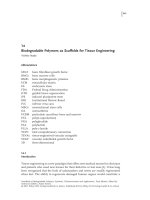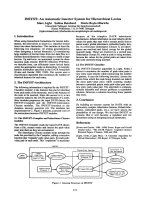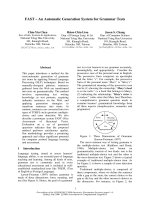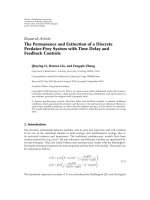Automatic microassembly system for tissue engineering assisted with top view and force control
Bạn đang xem bản rút gọn của tài liệu. Xem và tải ngay bản đầy đủ của tài liệu tại đây (1.57 MB, 127 trang )
Automatic Microassembly
System for Tissue Engineering
- Assisted with Top-View and Force Control
MENG QINGNIAN
NATIONAL UNIVERSITY OF SINGAPORE
2007
Acknowledgements
First and foremost, I want to express my most sincere gratitude to my supervisors, Dr.
TEO Chee Leong and Dr. Etienne BURDET, for their valuable supervision, constructive
guidance, incisive insight and enthusiastic encouragement throughout my project.
I wish to specifically thank Mr. ZHAO Guoyong, my partner in this project, for his
constant help in all aspects of this work.
I also express my appreciation to Dr. Franck Alexis CHOLLET and his group in the Micro
Machine Centre (MMC) at Nanyang Technology University (NTU) for his kind guidance
on the design and fabrication of the micro parts. I wish to thank Mr. MOHAMMED
Ashraf for his help in the cleanroom work and his friendship.
I also would like to thank National University of Singapore for their financial support and
research facilities. Without these supports, the study will not be possible. I am also
grateful to the staff in the Control and Mechatronics Lab, for their assistance and kindness.
My gratitude is also extended to the colleagues and friends in our lab and NUS, Mr. ZHU
Kunpeng, Mr. Du Tiehua, Mr. WANG Chen, Mr. WAN Jie, Mr. LU Zhe, Mr. ZHOU
Longjiang, Ms. SUI Dan and many others, for their enlightening discussion, suggestions
and friendship.
Finally, I owe my deepest thanks to my parents, my family, and my girlfriend, Ms. JI
Yingying, for their unconditional and selfless encouragement, love and support.
I
Table of Contents
Acknowledgements ............................................................................................... I
Table of Contents................................................................................................... II
Summary ......................................................................................................................V
List of Tables ......................................................................................................... VII
List of Figures ......................................................................................................VIII
Chapter 1
Introduction .................................................................................................................1
1.1 BACKGROUND...............................................................................................1
1.2 DEFINITION OF THE PROBLEMS ..........................................................5
1.3 OBJECTIVES AND SCOPES OF THE STUDY ....................................5
1.4 THESIS ORGANIZATION ...........................................................................8
Chapter 2
Literature review .....................................................................................................9
2.1 INTRODUCTION ............................................................................................9
2.2 LITERATURE REVIEW OF MICORASSEMBLY SYSTEMS .........9
2.2.1 MASTER-SLAVE SYSTEMS ..................................................................10
II
2.2.2 AUTOMATED ASSEMBLY SYSTEMS.................................................12
2.3 LITERATURE REVIEW OF MICRO FORCE SENSING
TECHNIQUES .......................................................................................................17
2.3.1 PIEZORESISTIVE SENSING (STRAIN GAUGES) ...............................18
2.3.2 PIEZOELECTRIC SENSING (“SELF-SENSING”) ................................21
2.3.3 CAPACITIVE SENSING..........................................................................24
2.3.4 OPTICAL TECHNIQUES BASED SENSING.........................................25
Chapter 3
Force sensor integrated micro gripper ..................................................29
3.1 INTRODUCTION ..........................................................................................29
3.2 ASSEMBLY FORCE ANALYSIS ............................................................32
3.3 DESIGN AND FABRICAITON OF MICRO GRIPPER .....................37
3.3.1 GRIPPING STRATEGY ...........................................................................37
3.3.2 GRIPPER DESIGN ...................................................................................40
3.3.3 GRIPPER FABRICATION .......................................................................47
3.4 DESIGN AND FABRICATION OF FORCE SENSOR ......................50
3.4.1 FORCE SENSING TECHNIQUE.............................................................50
3.4.2 SENSOR BODY DESIGN ........................................................................53
3.4.3 SENSOR FABRICATION AND SENSING MODULE
CONFIGURATION............................................................................................58
3.5 INTEGRATION AND CHARACTERIZATION ..................................61
3.6 CONCLUSION ...............................................................................................64
III
Chapter 4
Automatic assembly system .........................................................................67
4.1 INTRODUCTION ..........................................................................................67
4.2 PRECISION DESKTOP WORKSTATION ............................................68
4.3 COMPUTER CONTROL SOFTWARE...................................................72
4.3.1 CONTROL INTERFACE..........................................................................72
4.3.2 ADVANTAGES OF FORCE CONTROL FOR MICROASSEMBLY ....74
4.3.3 LIMITATION OF COMMERCIAL ACTUATOR AND THE
OPERATING ENVIRONMENT........................................................................78
4.3.4 FORCE-BASED ADMITTANCE CONTROL .........................................81
4.4 ASSEMBLY EXPERIMENTS AND RESULTS ...................................89
4.4.1 MICRO PART FABRICATION ...............................................................89
4.4.2 ASSEMBLY PROCESS AND RESULTS................................................92
4.5 CONCLUSION ...............................................................................................98
Chapter 5
Conclusions and future work .....................................................................100
5.1 CONCLUSIONS ........................................................................................100
5.2 FUTURE WORK .......................................................................................102
Bibliography ...........................................................................................................105
IV
Summary
One of the main problems of present automatic microassembly techniques is the lack of
the implementation of force control, especially the control of the assembly force or the
insertion force. This thesis develops techniques for efficient z-axis microassembly based
on force control of commercially available stages. These techniques arise from an
application in tissue engineering.
Microassembly technique has shown much potential in facilitating tissue regeneration
tasks. In this work, an automatic system is developed for building 3D tissue engineering
scaffold by assembling microscopic building blocks. The idea is to coat the micro parts
with specific and individual cells and bioagents, and then assemble them into 3D scaffold
in biocompatible environment with certain desired spatial distributions.
3D cross-like micro part was designed and fabricated for the assembly task. Its overall
dimension is 500 μm × 500 μm × 200 μm with a through hole in the centre of 100 μm in
diameter, and the wall thickness is 60 μm . The parts were fabricated from SU8 using
photolithography process. The structure allows assemble the parts only by pushing them
down from above, and then the parts will stick together by friction.
The developed 5 DOF desktop workstation contains five micron precision
micropositioning stages, one microscope and one force sensor integrated gripper. The
prototype micro probe gripper was fabricated using electrochemical etching technique,
V
with a photolithography fabricated pushing shoulder for assembly, with a fine tip that
matches the hole in the part for grasping. The force sensor was developed by attaching
two semiconductor strain gauges to a specifically designed elastic element. A force-based
admittance controller was implemented to the process for guiding the grasping and
assembling process.
Experimental results show high efficiency and high yield of the system. With the
admittance controller, the system is robust to the variation of the dimension of micro parts.
And we note that apart from the assembly tasks, this automated workstation can be used in
other applications such as manipulating biological cells or testing silicon chips.
VI
List of Tables
Table 2.1 Comparison between master-slave systems and automatic systems……..….16
Table 2-2 Popular force sensing technologies…………………………………………....28
Table 3-1 Forces during main assembly process……………………………………….36
Table 3-2 Important requirements for micro gripper design……………………...………39
Table 3-3 Popularly used gripping strategies………………………………...………….39
Table 3-4 Important Specifications of SS-027-013-500P……………………………...…53
Table 3-5 Important specifications of TML DC-92D………………………………..….61
Table 4-1 Main issues in microassembly……………………………………...………….68
Table 4-2 Main specifications of M-511.DD……………………………………………..70
VII
List of Figures
Figure1-1: (A) The scaffold assembly workstation previously used. (B) Amplification of
the Gripping part of the previous workstation. (C) A small scaffold under the previous
gripper compared with a human hair. (D) A large scaffold assembled (3x3x2mm)……… 6
Figure 3-1 (A) Side view of multiple parts. (B) Side view of single part…………...……29
Figure 3-2 Side view of the wafer containing the zero-plate and a scaffold………...……30
Figure 3-3 (A) Top view of multiple parts. (B) Top view of single part……………….31
Figure 3-4 Gravitational, van der Waals, surface tension, and electrostatic forces between
sphere and plane……………………………………………………………………….….33
Figure 3-5 (A) Old part. (B) New part with a hole…………………………..……….40
Figure 3-6 L-shape micro probe gripper………………………………………………….41
Figure 3-7 Deformation of the gripper during the insertion period………………...…….46
Figure 3-8 Bending deformation of tungsten rod of different dimension…………...……47
Figure 3-9 (A) Gripper fabrication setup. (B) Etching gripper probe in KOH
solution………………………………………………………………………...………….48
Figure 3-10 Tungsten rod etching: time and diameter………………………………...….48
Figure 3-11 (A) Fished probe gripper. (B) Etched tungsten rod. (C) Pushing
shoulder………………………………………………………………………………...…49
Figure 3-12 Evaluation of the performance of the micro probe gripper: (A) Top view of
the gripper and part. (B) Top view of the gripper with part and zero-plate. (C) Pick up the
part. (D) Release the part…………………………………………………………..51
Figure 3-13 Strain gauge SS-027-013-500P………………………………………...……52
Figure 3-14 Sensor body………………………………………………………………….53
Figure 3-15 Cantilever deformation………………………………………………...…….55
Figure 3-16 Calculation of relation between ε and h ……………………………..…….57
VIII
Figure 3-17 Calculation of relation between δ and h ……………………………..…….58
Figure 3-18 Integrated gripper and force sensing module…………………………...…62
Figure 3-19 Calibration by electrical balance: (A) force generated by gripper against
output signal (amplified and filtered) of semiconductor strain gauge bridge Cantilever is
horizontal. (B) Cantilever is 10 degrees angle to horizon………………………..………63
Figure 3-20 Sensor noise and drift when idle…………………………………………….64
Figure 3-21 Sensor noise and drift when loaded………………………………………….65
Figure 4-1 Precision desktop workstation………………………………………...………69
Figure 4-2 Control interface: (A) position and movement of each stage. (B) Reading from
force sensor. (C) Top-view of work space. (D) Control buttons………………………….73
Figure 4-3 Force characteristics during insertion at constant velocity ………………......75
Figure 4-4 Depth of successful inserted parts……………………….……………...…….77
Figure 4-5 Force of successful inserted parts……………….………………………......78
Figure 4-6 Complex trapezoidal mode motion……………………………………..…….79
Figure 4-7 Simple harmonic motion signal……………………………………...……….80
Figure 4-8 Force response to simple harmonic signal input……………………………81
Figure 4-9 Simulated model of end-effector and environment…………………………82
Figure 4-10 System control loop…………………………………………………………83
Figure 4-11 Effect of k to the insertion process………..………………………………85
Figure 4-12 Experimental result of admittance controller for grasping process with
different tip and hole position errors: (A) No position error; (B) Moderate position error
(about 25μm ); (C) Large position error (about 50 μm ); (D) Position error larger than
50 μm , cannot insert……………………………………………………………………87
Figure 4-13 Experimental result of admittance controller for assembly process with no
position error (A) and 5μm position error (B)……………………………………………88
Figure 4-14 Building block CAD drawing………………………………………...…….89
Figure 4-15 Lower layer fabrication process of part……………………...………………91
IX
Figure 4-16 Upper layer fabrication process of part……………………………………92
Figure 4-17 Flow chart of assembly process………………………………………...……95
Figure 4-18 A three-layer scaffold……………………………………………..…………97
Figure 4-19 Sticking force between parts after assembly………………………………97
X
Chapter 1 Introduction
Chapter 1
Introduction
1.1 BACKGROUND
Assembly is often required in macroscale product manufacturing in order to reduce the
complexity and cost of the manufacturing process. Assembly makes it possible to build
complex products from relatively simple parts and to integrate incompatible
manufacturing processes. It also makes maintenance and replacement possible. The
extension of assembly techniques into micro/meso-scale1 is driven by the development of
modern design and manufacturing technologies in the pursuit of miniaturization and
function integration. To miniaturize a product it is not sufficient to simply reduce its
dimensions. A lot of new problems emerge, related to scaling effects, manufacturing
problems and, of course, assembly problems. One of those problems has to do with the
fact that, up to now, nearly all production techniques for microsystems have their origin in
the microelectronics technology, and are essentially 2D processes.
In the last two decades, automatic microassembly has bloomed due to the demand of
micro photonics devices, electro-mechanical systems, and bioengineering, etc, and the
requirement is to improve productivity as well as the accuracy relative to manual assembly.
One of the main problems of present automatic microassembly techniques is the
1
Chapter 1 Introduction
implementation of force control, especially of the assembly force or the insertion force.
One solution is to use z-axis assembly, which can be found in some peg insertion tasks
and usually requires 3 or 4 DOF, with 2 for the locating and one or two for grasping
(Nakagaki H. et al, 1995), (Hara H. et al, 1997), (Bruzzone L.E. et al, 2002), etc. This
thesis develops techniques for efficient z-axis microassembly based on force control,
using commercially available stages.
These techniques arose from an application in tissue engineering. The loss or failure of an
organ or tissue is one of the most frequent, devastating, and costly problems in health care,
and transplantation surgery is always implemented to treat this disorder. Tissue
engineering, implementing tissue regeneration by autogenous cell transplantation, is a new
and promising technique, since it has the potential to provide the ideal autograft. This can
avoid almost all the limitations of conventional transplantation, such as gene rejection,
donor shortage, long-term survival problems, etc. (Langer, Vacanti, 1993). Most tissue
engineering strategies for creating functional replacement tissues of organs rely on the
application of temporary three-dimensional scaffolds to guide the proliferation and spread
of seeded cells in vitro and in vivo (Zhang, 2005). For example, matrix-producing
connective tissue cells or anchorage-dependent cells taken from a patient can be seeded
onto a three-dimensional scaffold in vitro. The scaffold is made to the shape of the wound,
should be covered by or immersed in culture liquid in advance. In this way, the cells will
proliferate, migrate and differentiate into the tissue while secreting the extracellular matrix
components required to create the tissue. In time the scaffold will degrade and be absorbed
2
Chapter 1 Introduction
by the growing cells as nutrition. Finally, the structure will function coordinately with the
rest of the body without complications.
To achieve the successful regeneration of tissues and organs, which includes cell survival,
signaling, growth, propagation and reorganization, as well as cell shape modeling, and
gene expressions that relate to cell growth and the preservation of native phenotypes, there
are certain requirements of the tissue engineering scaffolds’ materials, macro- and
microstructure properties, etc. as follows:
z
Material: The scaffolds materials are confined to those that are non-mutagenic (not
containing physical or chemical agent that changes the genetic information of an
organism), non-antigenic (not producing substances that stimulate immune response),
non-carcinogenic (not causing cancer), non-toxic and non-teratogenic (not leading to
malformations) and possess high cell/tissue biocompatibility, and most importantly,
should be biodegradable and bioresorbable (Leong et al, 2003).
z
Macrostructure: The choice of the temporary three-dimensional scaffold is crucial to
enable the cells to behave in the required manner to produce tissues and organs of the
desired shape and size.
z
Porosity and pore interconnectivity: The scaffold should be highly porous (exceeding
90%) in its surface and microstructure and have open-pore geometry, which will
ensure healthy growth of the seeded cells as well as the use of bioreactors (Vacanti et
al, 1988; Mikos et al, 1993).
z
Pore size: The microenvironment for the generation of different tissue is quite diverse.
Hence the pore size of the scaffold must be designed for the specific purpose. The
3
Chapter 1 Introduction
sizes usually vary from tens of to hundreds of microns (Robinson et al, 1995),
(Yannas et al, 1989), (Kim et al, 1998).
z
Surface area and surface chemistry: a large quantity of cells is needed to regenerate
the tissue or organ function, and so the internal surface area should be maximized to
hold those cells. And the surface chemistry, which is dependent on the material of the
scaffold, is important for the growth of the cells (Healy et al, 1992), (McClary et al,
2000).
z
Mechanical properties: The scaffold should have enough mechanical strength to
guide the tissue regeneration, especially during the degrading period of the scaffold
(Mikos et al, 1993).
Besides the previously listed pre-requisites for tissue regeneration scaffold, there are still
requirements for scaffold fabrication techniques, such as process accuracy, consistency,
repeatability, and etc.
Based on all these requirements, the major goal of bioresorbable 3-D scaffold fabrication
is to achieve high levels of accurate control over their macro- and microstructural
properties. A teleoperated scaffold microassembly system (Figure 1-1) based on manual
operation has been implemented and evaluated, and the goal of this thesis is to automate
the whole system by adding multisensory information of force and vision to it with
concentration on the force part.
4
Chapter 1 Introduction
1.2 DEFINITION OF THE PROBLEMS
Previously, the assembly process was accomplished by an operator through teleoperating
the workstation (Figure 1-1) on a PC. The operator can get the side views of the work
space through two microscopes, and use the visual information to control the assembly
process. The assembly task is to find the micro part for assembly on the wafer, move the
gripper to the part and pick it up, move the gripper to the assembly area and find the
position to put the part to assemble the structure. The manual assembly process has
several disadvantages:
z
Time consuming: Building a pyramid shape scaffold (Figure 1-1D) consisting of about
100 parts by an experienced operator using the system needs about one week, and a
scaffold for practice use may consist of thousands of parts.
z
Low accuracy: The gripper used previously (Figure 1-1C, D) can only grasp one
branch of the part. This will lead to an unbalanced pushing force and cause the part to
tilt. The whole process is controlled manually by a human operator, and this will also
decrease the accuracy of the assembled scaffold due to the limitation of human.
z
Operator dependence: An operator must be well trained before he or she can operate
the system, as the micro parts and the tip of the gripper are both in hundreds of
microns dimension and very fragile.
1.3 OBJECTIVES AND SCOPE OF THE STUDY
From the above listed disadvantages, it can be easily seen that most of the problems owing
to the operator being involved in much of the process. A solution is to make the assembly
process independent of the operator, which means to automate the whole process.
5
Chapter 1 Introduction
A
B
C
D
Figure1-1: (A) The scaffold assembly workstation previously used. (B) Amplification of
the Gripping part of the previous workstation. (C) A small scaffold under the previous
gripper compared with a human hair. (D) A large scaffold assembled (3x3x2mm).
6
Chapter 1 Introduction
Our goal is to develop a fast and high yield 3D microassembly which without damage the
parts during assembly. Previous works has emphasized the role of visual control in
microrobotics (Nelson et al, 1998), (Popa et al, 2002). These works as well as our
previous approach (Zhang et al, 2006) suggest that vision-based control is suitable to
perform automatic selection of a part and gross motion above the point of insertion, and
provide suitable techniques. However, it is difficult to control insertion using vision,
because of the very limited depth of focus due to the high magnification of the optical
microscope.
A review (Chapter 2) of micromanipulation systems literature shows that at least a
combination of force and vision information is needed for implementing automated
operation. This thesis carries out the first steps towards the automation. The objectives are:
z
To carry out systematic literature reviews on microassembly systems as well as micro
force sensing techniques.
z
To design and fabricate a new gripper.
z
To analyze the force the gripper encounters during the assembly process.
z
To design and fabricate the force sensor and integrate it to the system.
z
To implement a force control of the assembly process.
z
To implement and evaluate the new system for scaffold microassembly.
The automation of the microassembly system needs the integration of vision and force
information, and this thesis realizes the first steps of this objective. The assembly system
was modified both in hardware and software, which includes replacing two side-view
7
Chapter 1 Introduction
microscopes with one top-view microscope, replacing the gripper previously used with a
smaller one which will avoid the occlusion of the view, design and fabrication of the force
sensor, revising the control interface, integrating the whole system and evaluating it by
doing some assembly experiments.
1.4 THESIS ORGANIZATION
This thesis is organized as follows. Chapter 2 first reviews the current microassembly
systems, and two main categories: master-slave systems and automatic assembly systems
are presented. Then some main micro force sensing techniques as well as their
applications are reviewed, including piezoelectric sensors, piezoresistive sensors,
capacitive sensors and some optical sensors. Chapter 3 describes the design and prototype
fabrication of the force sensor integrated into the micro probe gripper. Chapter 4 presents
the dedicated desktop workstation used in the assembly task. A force-based admittance
controller is implemented in the grasping and assembling process. Then the system is
evaluated through scaffold assembly experiments, and a multi-layer scaffold is
successfully assembled. Finally chapter 5 concludes the work and proposes some research
directions for improving the proposed assembly technique.
8
Chapter 2 Literature review
Chapter 2
Literature review
2.1 INTRODUCTION
The trend toward miniaturization and high complexity makes it impossible to fabricate the
hybrid micro-scale devices in traditional ways. Recently, microassembly has been
proposed as a means to fulfill this need, while maintaining high yield and low cost
(Brussel et al, 2000). Scaling effects make the microassembly quite different from the
assembly in macro world, especially the forces in the micro world, which makes the micro
force sensing techniques the key to the automation of microassembly systems. The review
of the literature concentrates on microassembly systems and micro force sensing
techniques.
2.2 LITERATURE REVIEW OF MICORASSEMBLY
SYSTEMS
The scale difference between the micro- and macro-world and the required precision
associated with assembling micro parts under a microscope ask for advanced
microassembly tools. According to the sequence of the micro parts to be assembled, the
assembly systems can be categorized as serial microassembly, parallel microassembly and
stochastic microassembly (Cohn et al, 1998). Since the assembly strategy we are using is
9
Chapter 2 Literature review
serial, the review of the literature concentrates on the serial microassembly relevant
studies. The assembly systems can be generally categorized into two methodologies,
including master-slave systems and automatic assembly systems (Brussel et al, 2000).
2.2.1 MASTER-SLAVE SYSTEMS
When the size of the articles to be treated is too small, human being can no longer see or
feel it. Thus the work cannot be done in the same manner as in the macro world. In such
cases, teleoperation with scaling function is a solution to such problems, and master-slave
system is one example of such systems. Master-slave systems make the target’s scale to be
equal to our scale virtually. Thus, the human operator can control the slave manipulation
systems by maneuvering the master manipulator (Kaneko et al, 1995). Because of the
superior capabilities human has, such as objects discrimination, adaptation to changing
tasks, etc., this kind of assembly technique is widely used in life and biomedical field,
especially in small batch production.
The research on scaled master-slave systems can be traced back to the early 1990s, and
among them a bilateral controlled master-slave manipulator system has been developed by
Kobayashi (Kobayashi et al, 1993). Force, position and time scaling control methods were
proposed, and a bilateral control of the former two was realized by a micro-macro
telemanipulator. Strain gauges were used in both the master-grip and the slave-tweezers,
to measure the force that was added to the grip body and to measure the reaction force of
the target, respectively.
10
Chapter 2 Literature review
Scaled master-slave systems started to be extensively studied since it was proposed to be
used in biomedical purpose (Ikuta K. et al, 1994). A micro master-slave system was
proposed using force and position bilateral control, as well as “dither” technique, which is
proposed to improve the controllability of the system against friction. A remote minimally
invasive surgery (MIS) was implemented using the above system to verify its biomedical
use.
A micro-macro system using the control scheme based on force feedback bilateral control
with scaling transfer function gains was proposed and verified by some experiments in
(Kaneko et al, 1997). The control scheme provides the operator with the impedance
shaped out of the real one, the ratio of which was determined by the products of the force
scaling transfer function gain and the position scaling transfer function gain. This makes
the control scheme quite simple and suited for real systems and real-time control, and also
makes it more effective than the conventional bilateral control schemes.
Carrozza (Carrozza et al, 2000) developed a master-slave system aimed to study the force
control strategy in the micro gripper. A strain gauge integrated LIGA micro gripper was
used in experiments, and a model in the idling condition was derived, a study of which
indicates that an integrative action in control is needed to reach stability.
Literatures after 2000 show that master-slave systems are mainly used in biomedical
purpose, and most of the researches are proposed for such purpose. A master-slave type
tele-surgical system with intelligent user interface was development by Mitsuishi
11
Chapter 2 Literature review
(Mitsuishi et al, 2000). Multi-circular guides and “anti-shadow” techniques were adopted
in the control of the system to achieve the accuracy, rigidity of the slave manipulator and
the controllability of the system, and with these the suture of a 0.3 mm diameter microblood-vessel was achieved. Wang (Wang et al, 2005) developed a master-slave robot
system with force feedback for micro-surgery, and the validity of it was proved by
implementing the system on vas suture experiment on some animals. A 3-DOF scaled
micro-macro manipulation system was implemented by Speich and Goldfarb (Speich and
Goldfarb, 2005). The transparency bandwidth and the stability of the manipulator pair was
improved was achieved by using the loop-shaping compensators, which is enabled by
linearizing the feedback, and the results was demonstrated by experiments. A new method
for visual feedback for scaled teleoperation was proposed by Clanton (Clanton et al, 2006).
In this research the human operator manipulates the handle of a remote tool in the
presence of a registered virtual image of the target in real time. This method uses the
concept of a new medical device called Sonic Flashlight, which removes the in situ image
devices and makes the others objects in the workspace visible.
2.2.2 AUTOMATED ASSEMBLY SYSTEMS
Along with the rapid development of the fabrication techniques, more and more
complicated micro devices are widely used, which needs the microassembly systems to be
more precise, more efficient, and less costly. To fulfill this need, automatic assembly
systems are adopted extensively in those large batch productions. The in-depth study on
automatic microassembly systems can be traced back to more than 10 years ago, and at
that time there are some precise microrobots commercially available, such as MINIMAN
12
Chapter 2 Literature review
(MINIaturized MANipulator), PROHAM (Piezoelectric RObot for HAndling of
Microobjects), SPIDER I & II, etc. Those microrobots were almost all piezoelectric
actuated to achieve high resolution to several nanometers and capable of traveling over
long distance. And since then, more and more dedicated automatic microassembly
systems were designed and implemented to accomplish more complicated and difficult
tasks. Firstly only vision feedback was used (Sulzman et al, 1997), (Fatikow et al, 1999),
etc., and later force information was added to achieve faster and more accurate assembly
(Fung et al, 2001), etc.
An automatic micromanipulation desktop station equipped with piezoelectrically driven
microrobots was developed by (Fatikow and Rembold, 1996). The microrobot was placed
on the x-y-table of a highly precise microscope. A fine movement with the resolution of
10 nm can be achieved with the speed of several millimeters per second. A CCD camera
was used in the visual servo system to guide the endeffector positioning and
micromanipulation.
A microassembly station based on several mobile piezoelectric actuated microrobots was
presented by Seyfried (Seyfried, 1999). The microrobots performed the motions and
micromanipulation under the force control through several vision sensors either on an X-Y
stage under a microscope or in the chamber of a scanning electron microscope (SEM).
With the multi-robots system, the microassembly task can be achieved in parallel.
13
Chapter 2 Literature review
Wafer-level 3D microassembly workcell equipped with piezoelectric force sensor was
developed and experimented by Ge Yang (Ge Yang et al, 2001), (Ge Yang et al, 2003).
This station consists of several independent components: a multiple-view imaging system,
a piezoelectric force sensor, a 4 DOF micromanipulator, a 4 DOF positioning system, and
a flexible micro gripper. To achieve high reliability and efficiency, the wafer was set on a
vertical mount, and force feedback was applied as a complement to vision control to
achieve high precision, which has seldom been studied before.
The idea of “Ortho-tweezers” was first used in the design of the gripper by Thompson
(Thompson and Fearing, 2001), to realize a full automatic robotic microassembly. “Orthotweezers” gripper means the two finger of the gripper were orthogonal, which is more
easily implemented in the micron scale systems than anthropomorphic design. Strain
gauges were used in the force sensing module to facilitate the visual control to achieve
more accurate, faster motion. Sticking effects were also considered in the releasing
process.
Quan Zhou (Quan Zhou et al, 2002) developed a microassembly station in the purpose of
studying the influence of the ambient environmental parameters on microassembly.
During the experiments, the environmental temperature and humidity, the mechanical
vibration and air flow were changed, thereby causing the adhesion forces, the
microassembly system and the assembly system to change. The results showed that
environmental parameters affected the precision of the microassembly process as well as
the instruments used significantly.
14









